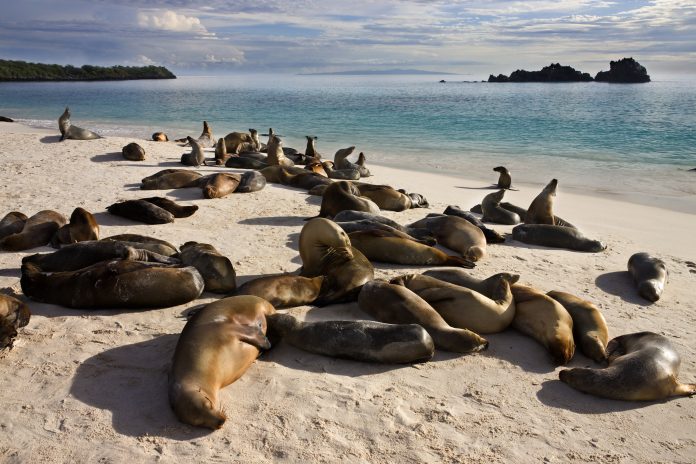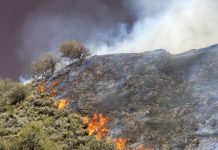Why conserve Galapagos? Clare Simm from the Galapagos Conservation Trust answers this vital question, discussing the immense vulnerability of the islands and the work being done to protect them
The Galapagos Islands, Ecuador, are one of the most unique but vulnerable places on Earth. Found 600 miles off the coast of South America, the Islands were isolated for millions of years. Now, however, Galapagos has reached a critical point in its history. The wildlife found there have not been able to adapt fast enough to the changing conditions brought on by humans residing in Galapagos, or the effects that we are having globally.
As the inspiration for Darwin’s ground-breaking theory of evolution by natural selection, Galapagos has given rise to an extraordinary mosaic of habitats and an unparalleled range of wildlife. From giant tortoises roaming the highlands to penguins diving for their prey, this is no ordinary island chain. However, evolutionary isolation has played a crucial role in their vulnerability as they now live alongside 30,000 people.
Over 50 Galapagos species are now listed as Critically Endangered on the IUCN Red List – and this list is increasing every year. Invasive species, such as rats and insects, are causing devastation among the native wildlife. Increasing urbanisation is resulting in the loss of pristine habitats. Overfishing, both by local and international fishing fleets, is disrupting the finely tuned marine balance. And climate change is providing additional pressure across the Islands’ ecosystems.
Galapagos Conservation Trust’s strategy
Islands can recover if such threats are removed or controlled, and local people are engaged with their environment. This is very much at the heart of what Galapagos Conservation Trust (GCT) is setting out to achieve. Our vision is of a Galapagos that is safeguarded into the future and, in 2020, we launched our latest three-year strategy to work towards this. By focussing on three core pillars of activity, we work to protect the unique species of the Archipelago, restore the Islands’ natural habitat, and provide sustainable solutions to issues such as plastic pollution.
Spanning all three pillars is our commitment to eradicating invasive species, tackling climate change impacts and engaging people and communities through our education and outreach work. This work could not be achieved without a strong communications strategy which we use to raise awareness and funds in the UK and in Galapagos, empowering people to act to protect the Islands.
Pioneering programmes
One of the greatest threats facing the world today is that of plastic pollution and, sadly, Galapagos is no exception. The majority of pollution found there has been shown to come from outside the Archipelago, but within the Eastern Pacific region. Tackling this threat is currently one of the highest priorities of the Galapagos National Park (GNP) and GCT is helping to drive forward the Plastic Pollution Free Galapagos programme. An alliance of NGOs, local communities and international scientists are now creating novel management tools, applying new techniques to identify polluters such as industrial fishing fleets, and testing best practice clean-up processes.
Technology-based tools are also in development to support evidence-based decisions at local, national and international levels to drive behaviour change using policy and education. The aim is to prove, in Galapagos, methods that can be applied to coastal national parks around the world. The alliance’s overriding view is that if we cannot solve this problem in Galapagos, nowhere is safe.
Another key programme that GCT is delivering is focussed on the Endangered Sharks of Galapagos. The Galapagos Marine Reserve (GMR) is home to one of the largest concentrations of sharks in the world. We support research that will ensure protection for these vulnerable sharks throughout their lifetime, from their nurseries in the GMR to their migration routes outside in the Eastern Pacific. Our work has supported the case for increased protected areas and reviewing management zonation within the GMR. We are now focussing on influencing decision-makers to create new marine protected areas outside of the GMR, such as safeguarding the Galapagos-Cocos swimway, a vital migration route for sharks and other key marine species between Galapagos and Cocos island, Costa Rica.
How research has been affected by COVID-19
In mid-March 2020, Galapagos went into lockdown. Non-residents were evacuated and all conservation fieldwork stopped. GCT had to adjust fieldwork and science programmes rapidly, providing additional support to our partners to enable them to continue their vital work, where possible. Some projects, such as that to protect the Critically Endangered mangrove finch, stopped completely, putting the lives of precious chicks at risk from the invasive avian vampire fly. Thankfully others, such as those researching Vulnerable Galapagos giant tortoises and Endangered whale sharks, were able to resume fieldwork fairly quickly and safely.
A key programme that was delayed was that to restore Floreana island to its former ecological glory. GCT is supporting partners to eradicate invasive mammals, which will benefit native flora and fauna, with the long-term goal to reintroduce locally extinct species. The eradication phase, involving baiting to remove rodents, was due to occur in 2021, but fieldwork was suspended in 2020.
It was also necessary to divert project funding to cover pandemic-related issues, therefore the eradication event has had to be postponed. While delays like this are frustrating, they do allow us to take advantage of emerging research, allowing us to better understand the species that we are protecting from extinction.
2020 was a year like no other. GCT, like many other organisations, had to quickly review our plans, balance the needs of our partners, and ensure that the Islands’ wildlife remained protected. However, with determination and professionalism, we overcame challenges, and our relationships on the Islands became stronger than ever. We are excited to see what 2021 will bring and remain committed to our mission to support, develop and promote projects that achieve measurable conservation, sustainable living and protection of the environment of Galapagos.












Good piece Clare!
Good piece Clare! Good work GCT!